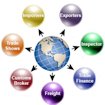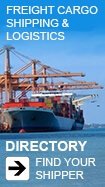Breaking Into The Trade Game: A Small Business Guide
Intro | Chapter 1 | International Business Plan | Chapter 2 | Chapter 3 | Chapter 4 | Chapter 5 | Chapter 6 | Chapter 7 | Chapter 8 | Part 2 | U.S. Department of Commerce | Small Business Development Centers | Foreign Chambers of Commerce in the U.S. | International Trade Organizations | Publications and Information Sources | International Calling CodesChapter 5 - The Export Transaction
Pricing
Pricing products to be competitive in international markets can be a challenge; pricing that works in one market may be totally uncompetitive in another. Although there is no one formula for establishing prices for exported products, there are a number of strategic and technical considerations that you can make in order to determine an appropriate pricing structure.
A pricing strategy is a key component of your export marketing plan. The selected pricing structure should be an integral part of your market penetration objectives. Your goals will vary depending on the target overseas market. Are you entering the market with a new or unique product?
Are you selling excess or obsolete products? Can your product demand a higher price because of brand recognition or superior quality? Maybe you are willing to reduce profits to gain market share for long-term growth. Your pricing decisions will be affected by your company's goals.
It is important to obtain as much information as possible on local market prices as part of your market research. Pricing information can be collected in several ways. One source is overseas distributors and agents of similar products of equivalent quality. When feasible, traveling to the country where your products will be sold provides an excellent opportunity to gather pricing information. U.S. Department of Commerce (DOC) can also assist in determining appropriate prices through its Customized Sales Survey.
Joseph S. Brown III, President of Bruce Foods Corp., obtained pricing information for food products sold in overseas markets using the Commerce Department's Customized Sales Survey. Although exporting since 1946, Brown is constantly on the look-out for new markets for his products: "We now export to 75 countries," the Louisiana business owner says.
To compile the Customized Sales Survey, DOC's US&FCS research specialists in the target country interview importers, distributors, retailers, wholesalers, end-users and local producers of comparable products. They also inspect similar products on the market. Your customized report, available for a fee, is usually completed within 45 days.
Marketing Your Product
To successfully market a product in a domestic market, the manufacturer must take into consideration consumer preference, industry standards, correct labelling and other consumer-driven considerations.
When entering a foreign market, the manufacturer should consider the tastes and preferences in each market as part of marketing strategy. Frequently, only a small change may be required to successfully market the product. The color of the product, the design of the package, the size of the product all may need adjustment.
Consideration should be given to the product name (it may inadvertently have a negative connotation in the local language), cultural and/or religious connotations, appearance of container, compliance to standards (different electrical power, metric dimensions and local product regulations).
Another consideration when planning market strategy is understanding ISO 9000. The International Organization of Standardization (ISO) was founded in 1946 by 25 national standardization organizations including the American National Standards Institute (ANSI). Ninety countries now hold membership in ISO.
In 1987, the ISO issued ISO 9000, a series of five documents (ISO 9000, 9001, 9002, 9003 and 9004) that provide guidance on the selection and implementation of an appropriate quality management program (system) for a supplier's operations. The purpose of the ISO 9000 series is to document, implement and demonstrate the quality assurance systems used by companies that supply goods and services internationally. ISO standards are required to be reviewed every five years. Revised versions are expected to be published in early 1994. Information on the status of these revisions can be obtained from:
The American Society for Quality Control (ASQC)
611 East Wisconsin Avenue
Milwaukee, WI 53202
Phone: 414/272-8575 or 800/248-1946
FAX: 414/272-1734
There are three ways for a manufacturer to prove compliance with the
requirements of one of the ISO 9000 standards. Manufacturers may evaluate their quality system and self-declare the conformance of the system to one of the ISO 9000 quality systems. Second-party evaluations occur when the buyer requires and conducts quality system evaluations of suppliers. These evaluations are mandatory only for companies wishing to become suppliers to that buyer. Third-party quality systems and evaluations and registrations may be voluntary or mandatory and are conducted by persons or organizations independent of both the supplier and the buyer. Interpretations of an ISO 9000 standard may not be consistent from one registrar to another.
The supplier's quality system is registered, not an individual product. Consequently, quality system registration does not imply product conformity to any given set of requirements. The demand for ISO 9000 registration in Europe and elsewhere seems to be coming primarily from the marketplace as a contractual rather than a regulatory requirement. As conformity to the ISO 9000 standards becomes recognized and required by foreign and domestic buyers and used by manufacturers as a competitive marketing tool, the demand for ISO 9000 compliance is expected to increase in non-regulated areas. It is therefore critical for manufacturers to determine what are their buyers' requirements regarding ISO 9000 compliance. Additional information on U.S., foreign and international voluntary standards, government regulations and rules of certification for nonagricultural products is available from:
National Center for Standards and Certification Information(NCSCI)
National Institute of Standards and Technology (NIST)
TRF Building, Room A163
Gaithersburg, MD 20899
Phone: 301/975-4040
FAX: 301/926-1559
For information on the EC 1992 Single Market program, copies of Single
Market regulations, background information on the EC or assistance regarding specific EC trade opportunities or potential problems, contact:
The Office of EC Affairs
International Trade Administration, Room 3036
14th and Constitution Avenue, N.W.
Washington, D.C. 20230
Phone: 202/482-5823
FAX: 202/482-2155
Methods of International Pricing
The cost-plus method of international pricing is based on your domestic price plus exporting costs (documentation expenses, freight charges, customs duties and international sales and promotional costs). Any costs not applicable, such as domestic marketing costs, are subtracted.
The cost-plus method allows you to maintain your domestic profit margin percentage, and thus to set a suitable price. This method does not, however, take into account local market conditions. Your price may be too high to compete in a foreign market.
Different marketing costs and/or modifications to the product could change the cost basis dramatically, making the product either more or less costly for export. As a result, using the "marginal-cost" method provides a more realistic means of determining true cost of producing your product for export.
To use the marginal-cost method, first determine the fixed costs of producing an additional unit for export. Fixed costs include production cost, overhead, administration and research and development. A cost saving may be realized if additional units of the product can be produced without increasing the fixed costs. There may also be instances where certain fixed costs are covered by domestic production and do not need to be added to export expenses.
Product modification expenses, dictated by the target market, are then added to the production costs to establish a "floor price." The floor price serves as a threshold for the firm to know when it would incur a loss. Using the floor price as a base, variable export costs for the product can be added. Some of the variable costs will be one-time or start-up expenses that should be discounted appropriately. Variable expenses include:
Packaging
Local regulations and customs may require special labelling, translated instructions or different packaging to appeal to local tastes. The selected mode of distribution may also require a particular kind of packaging.
Foreign Market Research
There may be fees for specialized services and publications used to gather market information.
Advertising and Marketing
Firms selling directly into new markets will most likely be responsible for the entire promotional effort. The firm can incur high initial outlays to establish product recognition in the new market. If an agent, distributor or trading company is employed, they can handle advertising and marketing as part of their contract.
Translation, Consulting and Legal Fees
Product instructions, sales agreements and other documentation typically will need to be translated into the local language. Expert translation of product labeling and instructions will enhance local marketing. Although many sales agreements are standard, it is advisable to have legal counsel review binding documents.
Foreign Agent/Distributor Product Information and TrainingAgents and distributors may require special training in order to effectively market and service your products. This is true even if the agent sells products similar to your firm's products. Training will not only enable the agent to better represent your company's interests but gain a better understanding of your particular product.
After-Sales Service Costs
Product warranties and service contracts will enhance your product's image as a quality item. An appropriate after sales service guarantee can support your sales efforts in the new market. Do not, however, promise service or warranties based on U.S. standards that you cannot deliver.
After taking these expenses into account, insurance, freight, duties and a profit margin can be added to arrive at a customer price. Depending on the market, currency fluctuations can affect significantly your locally based profit margin and the final price offered to the customer. For new-to-export companies, price products in U.S. dollars and request payment in dollars. This is not an unusual request.
High-Price Option
This approach may be appropriate if your company is selling a new product or if you are trying to position your product or service at the upper-end of the market. Selecting this option may attract competition and limit the market for your product while, at the same time, produce big profit margins.
Moderate-Price Option
This is a lower risk approach as contrasted to the high- or low-price option. Here you should be able to match competitors, build a market position and produce reasonable profit margins.
Low-Price Option
This approach may be relevant if you are trying to reduce inventory and do not have a long term commitment to the market. You will, no doubt, impede competition but also produce low profit margins.
There may be no single strategy that is ideal for every company. Often companies draw upon a mix of options for each market or product.
Setting Terms of Sale
Price Quotations
The pro-forma invoice is the most commonly used document to give price quotations to potential customers. The quotation in a pro-forma invoice is usually considered binding, although prices may change prior to final sale.
To prepare the invoice, you should give a detailed description of the product, an itemized list of charges and sale terms. Prices should be quoted in United States dollars to reduce foreign exchange risks. The invoice should also indicate the period during which the price quotation is valid.
You should be familiar with the common terms of sale used in international trade before preparing your pro-forma invoice. International Commercial Terms (INCOTERMS) are the universally recognized terms used in export and import contracts. These terms refer to the rights and obligations of each party: who pays what costs; when title to goods is transferred; and where the goods should be delivered. A complete list of INCOTERMS published in the book Incoterms 1990 can be obtained from the International Chamber of Commerce and should be a permanent part of your business library (see Part II, The Exporter's Directory).
PRO-FORMA INVOICE*
SHIPPER: Reference No. RB20693
Smith and Jones Co. Date: July 18, 1993
5555 Railroad Ave.
New York, N.Y. 10001 Customer P.O. No. 212-555-1234
Terms of Payment:
Estimated Date of Shipment
SOLD TO: SHIP TO: Grupo Estevez, S.A. de C.V. Juarez Industriale Tamales No. 1 Piso 2 454 Blvd. Cortez 12345 Cd. Polanco Mexico 11115 Mexico D.F. Mexico
VIA: Aero Cortez
ITEM QUANTITY DESCRIPTION UNIT PRICE TOTAL PRICE
100 Computer US $50.00 US $5,000.00
motherboards
FOB factory 5,000.00
Inland
Freight
Forwarder
fees 100.00
Air freight 1,200.00
Five (5)
sealed cartons Insurance 20.00
Gross weight:
10 lbs. C.I.F. Mexico 6,320.00
Authorized signature/Title
The above offering is based on current prices and is valid 60 days from invoice date.
*NOTE: This pro-forma invoice is only a sample. It is advisable to contact a freight forwarder in advance of shipping.
NEGOTIATING SALES AND DISTRIBUTOR AGREEMENTS
Sales Contracts
Knowing how to include INCOTERMS in a contract is important, but this represents only one aspect of the sales agreement. Legal rights and obligations of the parties should be spelled out in a single document, which can be incorporated into the final invoice. Frequently, the terms and conditions are contained on the back of the invoice.
Some of the terms and conditions necessary in a written sales agreement include:
Delivery Terms -- Risk of Loss
A force majeure clause is standard in most agreements. This clause excuses the exporter from responsibility where a default in performance is caused by events beyond the exporter's control, such as war, acts of God or labor problems.
Payment and Finance Terms
In addition to defining the terms of payment, provisions should be included for late payments, partial payments and remedies for non-payment. The terms of payment should consider the use of letters of credit.
Warranties
Sales contracts generally describe the goods and their qualities, workmanship and durability. In some cases, the exporter is obligated by the law in the country of import. The importer will require the exporter to warrant that the goods meet certain standards of construction and performance.
Acceptance of Goods
Frequently, the importer will insist upon the right to inspect the goods upon delivery; if found defective, the importer can reject them and refuse to pay. However, the importer is still liable for country-of-importation duties and other taxes. The export documents should reflect any such requirements.
Intellectual Property Rights
Protection of the exporter's patents, trademarks or copyrights should be assured in the agreement. However, protection under the laws of the foreign country are not automatic, and you should not assume that your product is protected.
Taxes
The obligations of the parties for payment of taxes other than customs duties should be defined in writing.
Dispute settlement
It is advisable to specify how and where any disputes will be resolved, as well as which nation's law would be applied. Bear in mind that different countries have varying arbitration laws and systems which may apply.
AGENT AND DISTRIBUTOR AGREEMENTS
If you choose to use an agent or distributor, it will be necessary to develop a formal contractual agreement. Agent and distributor agreements spell out in more detail the issues mentioned above and define other aspects of the relationship between the parties to the agreement.
In the contract it is important to:
- specify the goods and/or services covered;
- describe the agent or distributor's sales territory, and whether they will have exclusive or non-exclusive sales rights;
- set the length of the term for which the agreement is applicable and agree upon specified minimum sales volumes and objectives;
- outline protection of intellectual property;
- describe other types of obligations imposed on the parties, violations of which would justify termination of the contract; and
- list specific intellectual property rights granted to the agent or distributor.
When negotiating and drafting contractual agreements, it is recommended that you consult an attorney with experience in international trade and exporting. Your company's business lawyer may be able to handle your questions or refer you to an "export-oriented" attorney. Your local bar association may provide referral services, as well.
Under agreement with the Federal Bar Association and DOC, SBA sponsors the Export Legal Assistance Network (ELAN). ELAN is a network of attorneys located throughout the United States who specialize in international trade.
Your local SBA office can assist in locating an ELAN attorney who will provide a free, initial legal consultation to discuss your export-related questions.
As an initial introduction, however, you may want to review the information contained in International Business Practices, which covers the legal aspects of doing business in over 100 countries. Copies are available from US&FCS offices or from the Government Printing Office.
Terms for financing export sales should be discussed during contract negotiations. While the U.S. seller will want to be paid as soon as possible, the foreign buyer will want to delay payment as long as possible, preferably until after the goods are resold. These two conflicting objectives will factor into any negotiations on export financing.
In addition to reaching a compromise on the method of payment, the U.S. exporter must also be able to offer the foreign buyer favorable financing terms -- otherwise the sale could be lost to a foreign competitor with an equivalent product but better payment terms.
The final step in completing the export transaction is arranging for payment, the subject of Chapter 6, "Export Financing."
Next: Chapter 6 - Export Financing
- Source from manufacturers worldwide
- Find inspection, freight services and more
- Access global trade resources and guides
- Be part of largest global trade community and much more...
- Be where your customers are!
- Promote and market your services
- Receive direct quote requests
- Back office support, set up regional offices and much more...



